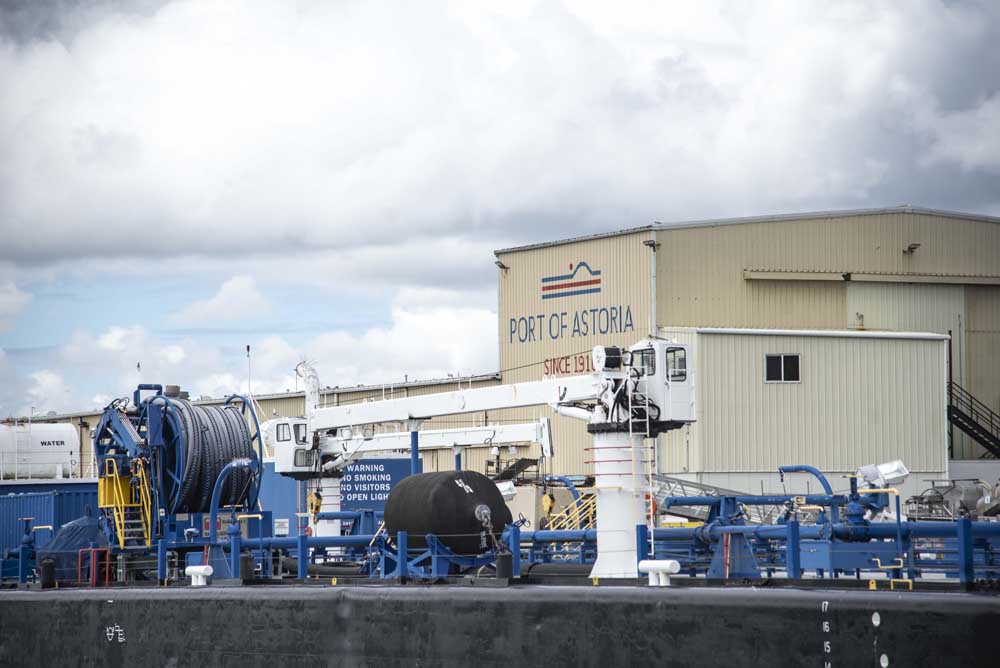County hopes to address mounting waste management challenge
Published 9:30 am Monday, January 29, 2024

- Astoria’s wastewater treatment lagoons in Alderbrook have capacity limitations.
Clyde McDonald is counting down the seconds. As the former owner of Ed’s Septic Tank Cleaning Service, he’s watched for years as disposal locations have dropped off the map in Clatsop County.
First, Astoria stopped accepting septage at its wastewater treatment facility. Then, Warrenton followed. Now, the company’s new owners — McDonald’s brother and sister-in-law, Paul and Lezlie McDonald — are sending their trucks as far as Longview, St. Helens and Rainier to keep the business going. Even at those locations, they’ve been limited to dumping as little as half a truck of septage per day — a fraction of what they need to meet their customers’ demands.
McDonald fears it’s only a matter of time before residents’ overfull septic tanks begin to contaminate the nearby groundwater.
“They’re backing up, and they’re overflowing, and we can’t get to them,” Lezlie McDonald said.
Septage haulers like the McDonalds aren’t the only ones with a problem on their hands. In the face of new restrictions, breweries and seafood processing plants in Astoria and Warrenton are facing their own waste management challenges.
To stay in compliance with the city’s pretreatment requirements, some Astoria breweries have taken on the expensive task of side-streaming wastewater — a process that leaves them with truckloads of organic materials like yeast and hops to dispose. At the same time, seafood processing plants are running up against waste management dilemmas as they navigate new restrictions from the Oregon Department of Environmental Quality.
In light of these hurdles, county leaders are moving forward with a feasibility study for a project they hope can offer a solution: an anaerobic biodigester. The study, they say, will help the county determine whether the project could bring in new infrastructure to process businesses’ waste and repurpose it for renewable energy.
Searching for solutions
In 2021, Oregon’s North Coast Regional Solutions team approached the county to ask if it would take the lead on addressing community waste management concerns. The same year, the county put out a request for proposals for an organic materials recovery and bioenergy feasibility study.
Assistant County Manager Monica Steele said although the county itself doesn’t operate any wastewater treatment plants, it still recognized waste management as a countywide issue.
“Our role in this is directly trying to support the businesses that are impacted, as well as the cities and what they’re able to do with the infrastructure that they have,” she said.
The county has contracted with Jacobs Solutions to complete an initial phase of the study and has begun a second phase that will wrap up in June. The study will help decide whether anaerobic digestion is a viable option.
Anaerobic digestion is a process where organic materials are placed into a large, oxygen-free tank. Under these conditions, microorganisms will begin to break down the materials and produce biogas containing methane, which can be used for heat and energy production.
“You’re taking this organic material that would otherwise result in methane production and off-gassing as a greenhouse gas, and you’re putting it to beneficial use,” said Dave Moldal, senior program manager in the renewables sector at Energy Trust of Oregon, a nonprofit that supports renewable energy projects across the state.
In Oregon, anaerobic digesters are typically found at large municipal wastewater treatment plants. In some areas, like Tillamook County, they’re also used to process waste at dairies.
The technology has been successful in a handful of Oregon communities, like Gresham, which adds fats, oil and grease to two anaerobic digesters at its wastewater treatment plant to increase biogas production. The energy from those digesters has helped the facility reach net-zero status, meaning they produce more power than they consume on an annual basis.
Whether an anaerobic digester could yield similar success in Clatsop County, however, is a question yet to be answered. For one thing, the county’s particular combination of feedstocks — primarily septage, brewery waste and stickwater from seafood processing — is somewhat uncommon. For another, anaerobic digesters require consistent inputs to work effectively.
“It can be done anywhere. But the question is, can it be done anywhere economically?” Moldal said. “What are the capital costs? What are the benefits in terms of biogas production or renewable energy? What’s the value of its energy?”
Phase two of the county’s feasibility study — which costs about $248,000 and includes digestion pilot testing, public outreach and siting development — will help answer some of those questions. Initial estimates indicate that an anaerobic digester could be a capital investment of between $40 million and $50 million, but the county will have a more accurate estimate once they’ve had a chance to look at more grant opportunities and private partnerships during phase two.
Cities, breweries navigate challenges
Paul and Lezlie McDonald said an anaerobic digester could help address their septage hauling concerns — but the project could take up to five years to complete, assuming it’s deemed viable. In the interim, they’re still faced with a difficult and costly reality: four-hour-long septage hauling trips, sometimes to multiple locations in a day.
At this point, there’s not much local wastewater treatment plants can do to help.
Last June, Warrenton’s wastewater treatment plant had surpassed 90% capacity. The facility can’t accept septage, and although the city has plans to upgrade in 2026 or 2027, City Manager Esther Moberg said they’d need to review new capacity levels before making any changes.
“Even with building a new facility, I would have concerns about immediately doing that without the biodigester because we don’t want to suddenly say, ‘Hey, we built this nice, shiny new wastewater treatment plant. Well, now we’re filling it up as fast as possible,’” Moberg said. “We have to be cognizant we are one of the areas that has the most capacity for new industrial growth in our county as well as new housing.”
Astoria’s wastewater treatment plant has similar limitations. The system consists of a series of 40-year-old treatment lagoons that aerobically digest waste. Jeff Harrington, the city public works director, said for the system to work effectively, it needs to have the right balance of oxygen, pH and temperature.
Adding septage wouldn’t bode well with that balance.
“All of a sudden, you’ve dumped in truckloads of waste that’s already digested,” Harrington said. “It’d be like, you know, eating too much sauerkraut. It would just destroy your stomach, especially if you ate 10 gallons of it a day.”
The treatment lagoons’ capacity limitations have also had implications for the city’s breweries.
A few years ago, Astoria began reporting high levels of organic materials at the wastewater treatment plant, bringing biochemical oxygen demand levels three times higher than they should be, Harrington said. To help address these concerns, the city adopted a pretreatment ordinance in 2022 and issued industrial discharge permits for the breweries, requiring them to treat wastewater to a certain level before sending it down the drain.
The new requirements have helped keep issues at the wastewater treatment plant at bay, but they’ve also shifted more responsibility to the fermentation sector.
“We had to figure it out on the fly,” said Chris Nemlowill, the president and co-founder of Fort George Brewery. “It was a real big jump because we’re used to making beer and selling beer and running a pub. None of us had any experience creating our own wastewater treatment plant.”
The process of brewing beer typically yields organic byproducts like sugarwater, yeast and hops. To stay within the city’s requirements, Fort George uses a series of pneumatic pumps to suck those materials out of its leftover water and pump them into a 6,000-gallon tank through a process called side-streaming. From there, the side stream is trucked off to a farm. The brewery has also invested in a BioGill, which uses screens with bacteria to eat at the remaining materials before they go down the drain.
Buoy Beer Co. follows a side-streaming process as well, and has plans to install a BioGill soon. The process has posed immense challenges for the company, especially when it comes to the cost and logistics of hauling side-stream off-site, marketing manager Jessyka Dart-Mclean said in an email. A local option to access a biodigester would be great, she added, although bringing one to Clatsop County could be an expensive and complicated process.
Nemlowill has witnessed the pretreatment requirements’ financial and logistical toll at Fort George, too. He said a biodigester could be one solution to waste management concerns, but it would still require them to haul their waste off-site to dispose of, which thus far has proven costly.
“If there was a place basically we could bring our side-stream to that didn’t cost anything — if there was basically a free tippage fee and they could generate power out of it or renewable natural gas — that would be fantastic,” he said. “I just haven’t quite seen a financial situation where that would make sense.”
One element of the county’s phase two feasibility study is a transportation cost analysis, which would help businesses determine whether hauling waste to an anaerobic digester in the county would be more affordable than their current waste disposal arrangements.
In a perfect world, Nemlowill said he’d like to see the city improve its existing infrastructure so that Fort George wouldn’t have to put its wastewater on a truck at all. Although the city is working through a wastewater treatment plant improvement project, Harrington said pretreatment requirements for breweries will likely stay the same after completion.
Seafood processors adapt
While breweries navigate waste management challenges, the county’s seafood processing plants are contending with new restrictions from the Department of Environmental Quality.
Generally speaking, seafood processors send leftover solid waste — scraps like heads, tails and bones — to a rendering facility to be made into products like bone meal, fish meal, fish oil and fertilizer. Once the bones, oils and insoluble proteins have been extracted from that waste, the facility is left with a viscous mixture of soluble proteins called stickwater.
“I would describe it as like a syrup,” said Amy Wentworth, director of environmental health and safety at Pacific Seafood, which operates a processing facility in Warrenton. “It’s thicker than water, but isn’t quite to the stage of like pudding or something like that.”
Da Yang Seafood’s Astoria facility sends solid waste to a rendering facility in Canada, said Alan Ismond, a consultant for the company. He believes the liquid waste that the company processes locally likely wouldn’t be a great fit for anaerobic digestion because of its low density and salt content.
Da Yang and Bornstein Seafoods also have a partnership with Scoular, a company that offers supply chain solutions for grain, animal feed and pet food suppliers. Scoular’s plant at the Port of Astoria’s Airport Industrial Park in Warrenton will likely begin accepting solid waste from the two processors to be made into fish meal and fish oil this spring.
Pacific Seafood, on the other hand, runs its own recycling facility in Warrenton. Now more than ever, they’re in need of stickwater disposal options.
Until recently, Pacific Seafood was allowed to discharge stickwater into the Columbia River — but that isn’t the case under new Department of Environmental Quality standards. While the company can still discharge into the river while it works through an appeal process with the agency, those provisions might not last forever.
Wentworth said adding the infrastructure needed to dry and process stickwater would cost tens of millions of dollars, and the Oregon and Washington state facilities that do have those capabilities are unable to accept Pacific Seafood’s waste. With these options effectively off the table, the company is left with few options beyond barging their stickwater or sending it to a landfill.
“If we were unable to discharge it, and if we’re unable to barge out to sea and we’re unable to bring the stickwater to another facility, then we would have to close, and that would have huge impacts on the seafood processing industry in Clatsop County because we’re one of the biggest processors there,” Wentworth said.
Wentworth said Pacific Seafood is very interested in the potential for an anaerobic digester, and the Clackamas-based seafood giant has participated fully in conversations with the county.
“We really do need help, and we need these types of relationships with the county, or anyone, you know, to help keep our industry alive,” she said.
Assistant County Manager Steele echoed that sentiment.
The seafood and fermentation industries are both major contributors to the local economy. Pursuing a bioenergy feasibility study, she said, is about working together with cities and businesses to navigate challenges and keep the door open for economic development.
“As a county, we want to support economic growth in a variety of sectors, and so whatever we can do to try and help find alternative solutions, we want to support that, understanding that cities are limited in their infrastructure capacity and what they’re able to do,” Steele said.





